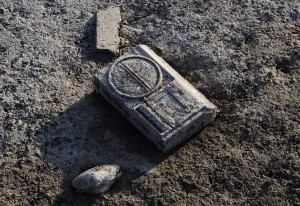Here Are 5 Challenges to Texas Water That Might Surprise You

EPA/LARRY W. SMITH /LANDOV
An old radio lies in the mud exposed after the water has gone at Lake Arrowhead State Park near Wichita Falls, Texas, in September 2013
With nearly 70 percent of the state still stuck in a drought that has dragged on for years, there’s been plenty of talk about how to strengthen water supplies in Texas. A multi-billion-dollar water fund (the passage of Proposition 6 last election) is in the works that will help fund projects like reservoirs, desalination and conservation. And there’s ongoing discussion and debate about the elephant in the aquifer: ways to change how groundwater is regulated, which took up a whole day of testimony at the state legislature this week. But that’s not all.
Beyond those two big-ticket items — how to pay for water supplies and how to regulate water underground — there are some other smaller challenges the state faces when it comes to water. At a hearing by the House Natural Resources Committee Thursday, several state agencies told lawmakers about the water challenges they’re dealing with. Here’s five issues that caught our attention:
1. ‘Toilet to Tap’ Could Mean Drier Rivers Downstream
Water reuse is picking up in Texas, but it could create problems for downriver communities. Customers currently pump treated wastewater back into a river, where its carried downstream to be treated and used again, but better techniques and technologies in water reuse are upsetting that system. Now communities like Wichita Falls in North Texas are moving towards direct wastewater reuse, and when that happens, there’s less water flowing downstream.
“If we see more and more communities trying to capture and keep their return flows, then we’re going to have a heck of a problem, not only for the bays and estuaries but also for communities, farmers and industry all down the stream,” said state Rep. Doug Miller (R-New Braunfels).
The City of Wichita Falls recently built a direct reuse facility that pumps treated wastewater directly to a facility to be treated as drinking water. The TCEQ is currently reviewing verification tests of the reuse system before the water is put into distribution. The Colorado River Municipal Water District takes wastewater from the City of Big Spring to produce 1.8 million gallons of potable water a day.
“In general, we are seeing more communities wanting to reuse their wastewater. And certainly that water wouldn’t be flowing downstream,” said L’Oreal Stepney, Director of Water with the Texas Commission on Environmental Quality (TCEQ).
The City of Brownwood has been approved for a wastewater reuse system, but construction hasn’t started yet.
2. Disposal Wells Could Make Desalination Cheaper
As Texas explores new water sources, desalination of brackish water underground has proven possible but expensive, partly because of costs to treat the salt-and-mineral brine left over from the process.
Some members of the committee wondered if desalination brine could be injected into the same wells used to store wastewater from “fracking” and oil and gas production, but federal legislation exclusively restricts use of deep-injection wells to the drilling industry. Some of those disposal wells have been linked to earthquake swarms in parts of the state that hardly had tremors before.
“There’ve been a lot of questions for how to use Class 2 wells for disposal of desalination concentrate. The fundamental problem is that the whole [Underground Injection Control Program] is established at the federal level, and at the federal level there is a separation between oil and gas exploration and everything else,” said Charles Maguire, director of the radioactive materials division at TCEQ.
If the brine were generated during oil and gas exploration it could be injected into wells, but not if it’s produced in municipal water treatment. Committee members instructed the TCEQ to explore an amendment to the rule to expand legal uses of deep injection wells.
“We’ve already got adequate coverage in disposal wells across the state. It’s just getting access to move that concentrate over there and not have to go through the process of treating it,” said Rep. Lyle Larson.
3. Invasive Species Threaten Water Supplies
Aquatic invasive species — plants and animals not native to Texas that have harmed some habitats — damage Texas water infrastructure and cause millions of dollars in maintenance and repair costs. The Texas Parks & Wildlife Department (TPWD) told the committee that the $1.4 million currently devoted to invasive aquatic species control allows them to manage only about four percent of issues.
“We know how to address the problem, we just need the funding to do it,” said Tim Birdsong, Chief of Habitat Conservation with the Inland Fisheries Division.
Hydrilla, an aquatic invasive species, has clogged the Lower Rio Grande River so much that up to 30 percent more water has to be released to push flows through the congested waterway, said Birdsong. After Hydrilla clogged Austin’s Tom Miller Dam in 2003, it cost about $300,000 to stop and clean hydroelectric generators.
Zebra mussels, introduced to Texas in 2009, have been found in seven Texas lakes and can colonize and clog water intakes for power plants and treatment facilities. A statewide rule to drain boats on all Texas lakes to prevent the mussles from spreading further takes effect next week.
In East Texas, Giant Salvinia has grown over large portions of Toledo bend Reservoir and Caddo Lake, Texas’ only natural lake.
“It is just breathtaking when you see the amount of giant salvania that’s covering the surface of [Toledo Bend Reservoir]. It’s truly a crisis in my opinion,” said state Rep. Trent Ashby (R-Lufkin). “These aquatic invasive species are a major problem for our surface water reservoirs.”
Aquatic invasive species cost the U.S. over $140 billion annually, Birdsong said.
“Studies have shown that infestations of water hyacinth, a floating aquatic invasive plant, can increase the rate of evaporation water loss by up to 13 times that of open water. Another species, giant reed, can form dense stands along stream corridors that can use up to 12 times an much water as native vegetation,” said Birdsong.
4. City vs. Country
Ahead of dishing out funds to improve Texas water infrastructure, the Texas Water Development Board (TWDB) has appointed a Rural Texas Ombudsperson to better involve rural communities in the development of new water projects.
“The ombudsman’s job is to go out and educate the agricultural and rural communities about the efforts that we have within the board that can assist them,” said Carlos Rubinstein, Chair of the TWDB.
The new ombudsman, Doug Shaw, grew up on a Texas farm and has been traveling up to 3,000 miles a month recently talking with rural communities about their water needs and concerns, Rubinstein said.
Shaw will help rural communities understand the board’s newly published proposed rules on how applications for water projects will be evaluated for funding.
“The proposed rule attempts to achieve a balance between points that urban and rural projects will receive,” Rubinstein said.
Urban projects will get high points for serving large population,s but rural projects will score high for supplying a large portion of local users’ total water demand. At least ten percent of funding must go to rural projects.
5. Fighting Evaporation, One Molecule at a Time
The City of Wichita Falls submitted a request to try evaporation suppression chemicals on some of their reservoirs for drinking water supply.
“There’s not a lot of research on them, but we did find some even going back to the sixties after the 1950s drought, where some pilots were done on some pretty large lakes,” said Stepney of the TCEQ.
Evaporation is generally among the largest sources of water loss from reservoirs in Texas. More water evaporates from the Highland Lakes each year than the City of Austin consumes, for instance. The chemicals would combat evaporation by creating a fine film across the tops of reservoirs.
The TCEQ approved a pilot project for use of the chemical polymers on Wichita Falls reservoirs, which are currently below 30 percent capacity, according to Stepney.
Want to learn more about the drought and water in Texas? Read our explainer: Everything You Need to Know About the Texas Drought.

